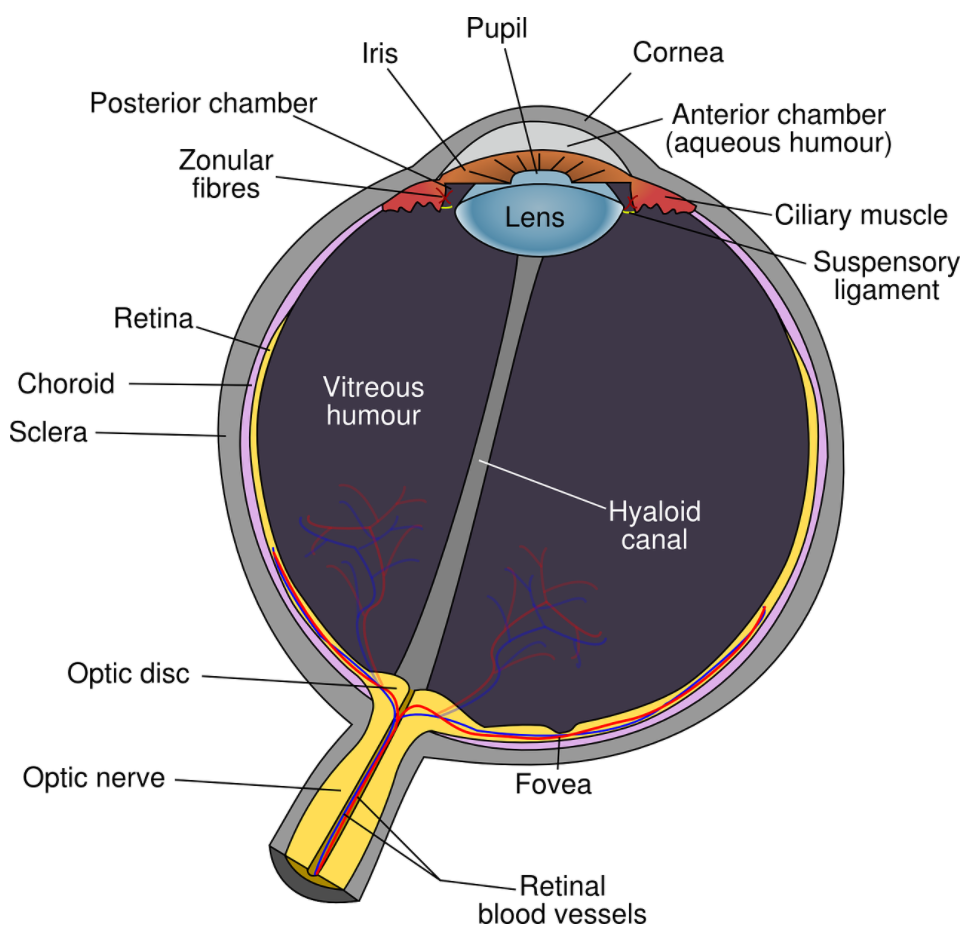
Draw a diagram of vertical section of human eye and label the following parts:
(i) Fovea
(ii) Lens
Answer
561.6k+ views
Hint: Eyes, most important of all human senses, allow us to experience this beautiful and colourful world. The binocular vision of humans allows us to see a single combined image formed by our both eyes. Our eyes are of the shape of an asymmetrical globe and have approximately one inch diameter. Our eyes depend upon our brain to interpret what we see.
Complete Answer:
- The parts of our eyes are categorized as external and internal based on their location and function. The external components of our eyes include eyelids, eyelashes, cornea, iris and pupil. The internal components of our eyes are lens, retina, macula, fovea, sclera, choroid and optic disc. Each of these components have specific parts to play to allow us to see an image.
- The fovea and lens are part of internal components of our eyes.
Let’s first get to know the eye parts mentioned in the question for better understanding and to localize them in the diagram.
(i) Fovea: Fovea is located in the macula of the retina and it is shaped like a tiny pit. It is in the centre of macula. The small, very sensitive area in the retina of our eyes is known as macula. The fovea has the highest concentration of cone cells, the cells in our retina are responsible for bright light vision. It provides clearest vision which is necessary for driving, reading or activities which needs minute details of the visual in humans.
(ii) Lens: The lens is an internal component of our eyes and is located directly behind the iris and the pupil. It is made up of transparent and flexible tissues. Like cornea, it also helps to focus light and images on the retina of our eyes. Because of the flexible nature of the lens, the curved shape of the lens can be changed to focus on objects that are near or far from our eyesight. The 25-30% of focusing power of eyes is contributed by the lens. The ciliary muscles of the lens are responsible for changing the shape and curvature of the lens.
The diagram given below is of the vertical section of the eye and the said parts are labelled in it.

Note: The lens has flexible and elastic nature which is helpful while seeing near and far objects. The lens, when focusing on near objects, becomes more rounded. While focusing on objects located at far distance, the lens becomes more stretched or elongated.
Complete Answer:
- The parts of our eyes are categorized as external and internal based on their location and function. The external components of our eyes include eyelids, eyelashes, cornea, iris and pupil. The internal components of our eyes are lens, retina, macula, fovea, sclera, choroid and optic disc. Each of these components have specific parts to play to allow us to see an image.
- The fovea and lens are part of internal components of our eyes.
Let’s first get to know the eye parts mentioned in the question for better understanding and to localize them in the diagram.
(i) Fovea: Fovea is located in the macula of the retina and it is shaped like a tiny pit. It is in the centre of macula. The small, very sensitive area in the retina of our eyes is known as macula. The fovea has the highest concentration of cone cells, the cells in our retina are responsible for bright light vision. It provides clearest vision which is necessary for driving, reading or activities which needs minute details of the visual in humans.
(ii) Lens: The lens is an internal component of our eyes and is located directly behind the iris and the pupil. It is made up of transparent and flexible tissues. Like cornea, it also helps to focus light and images on the retina of our eyes. Because of the flexible nature of the lens, the curved shape of the lens can be changed to focus on objects that are near or far from our eyesight. The 25-30% of focusing power of eyes is contributed by the lens. The ciliary muscles of the lens are responsible for changing the shape and curvature of the lens.
The diagram given below is of the vertical section of the eye and the said parts are labelled in it.

Note: The lens has flexible and elastic nature which is helpful while seeing near and far objects. The lens, when focusing on near objects, becomes more rounded. While focusing on objects located at far distance, the lens becomes more stretched or elongated.
Recently Updated Pages
Two men on either side of the cliff 90m height observe class 10 maths CBSE

Cutting of the Chinese melon means A The business and class 10 social science CBSE

Show an aquatic food chain using the following organisms class 10 biology CBSE

How is gypsum formed class 10 chemistry CBSE

If the line 3x + 4y 24 0 intersects the xaxis at t-class-10-maths-CBSE

Sugar present in DNA is A Heptose B Hexone C Tetrose class 10 biology CBSE

Trending doubts
Why is there a time difference of about 5 hours between class 10 social science CBSE

What is the median of the first 10 natural numbers class 10 maths CBSE

Indias first jute mill was established in 1854 in A class 10 social science CBSE

Indias first jute mill was established in 1854 in A class 10 social science CBSE

Write a letter to the principal requesting him to grant class 10 english CBSE

The Equation xxx + 2 is Satisfied when x is Equal to Class 10 Maths




